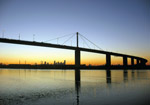
Bridging the Gap
Fiber-optic solutions helps Australian city manage traffic, incidents
- By Megan Weadock
- Apr 01, 2010
In the days before fiber optics, certain surveillance
applications simply weren't possible—or
too expensive to even be considered feasible.
In the past, that would have been the case at the
West Gate Bridge in Melbourne, Australia, where a
fiber-optic solution from Infinova is now linking cameras
to the city's video depot, miles away. West Gate is
Australia's third-longest bridge, stretching a total of
8,473 feet across the Yarra River. The beautiful cable-stayed
bridge, which was built in the 1970s, is twice as
long as the Sydney Harbour Bridge.
Mark S. Wilson, Infinova's vice president of
marketing, said the city chose Infinova because the
company has completed many high-profile projects
throughout Australia and Asia. The installation was
finished in the first quarter of 2009.
"This bridge is just one of many major infrastructure
projects that have turned to Infinova fiber optics
for more efficient, quality transmissions of images,"
Wilson said. "Since high-performance surveillance systems
require greater reliability and increased throughput,
the leaps forward in CCTV system technology
have increased the demand for Infinova fiber optics."
Keeping Watch
The West Gate Bridge installation includes an Infinova
N3731 Series fiber-optic transmitter, which transmits
one digitally encoded video channel with a bidirectional
RS-232/RS-422 contact closure and DIP
selectable data over one or two fibers.
The transmitter receives video from the PTZ dome
camera on the bridge and delivers it to the West Gate
Bridge Depot via fiber. Another N3731 Series transmitter
collects the video at the depot. This enables security
officers to monitor traffic and react quickly to
any incidents on the bridge.
Video from the bridge is simultaneously distributed
to an Infinova N3790 Series transmitter for
transmission over a single fiber to Melbourne City for
remote monitoring. Meanwhile, the transmitter sends
PTZ control data to the dome cameras via fiber. As
a result, officers who are several miles away can view
and control the PTZ control function of the cameras
on the bridge.
"[Prior to the new installation], there was a former
surveillance system on the bridge, but it was a
very basic set-up with limited coverage," Wilson said.
"Authorities wanted a system that would let them see
all parts of the bridge at all times in order to ensure
orderly traffic flow and catch any pedestrians not
authorized to be on the bridge."
Infinova's N3790 Series is a digitally encoded,
expandable and flexible fiber-optics transmission
system. Data formats support RS-232, RS-422, twowire/
four-wire RS-485, Manchester/Biphase and contact
closures. The transmitters use CWDM technology
to transmit up to 64 channels of NTSC, PAL or
SECAM video, 32 channels of audio, 32 channels of
data, 32 channels of contact closure signal or eight
channels of intercom.
The Future of Transmission
Around the globe, the demand for high-performance
surveillance systems—which require greater reliability
and increased throughput—has in turn led to a greater
demand for fiber optics. At the West Gate Bridge,
for example, fiber optics better preserves the quality
of video signals, providing a high level of security,
transmitting at higher data transfer rates, operating
at distances five times greater than coaxial cable and
leading to lower signal losses, strong data protection
and a longer life for the system.
"Because of the importance of this bridge, it was
imperative to get more signals from the camera end to
the monitor end over greater distances and in harsher
environments," Wilson said.
The fiber-optic system also allows the bridge operators
to leverage other, lesser-known benefits. For
example, they are able to avoid problems with electromagnetic
interference, radio frequency interference,
cross-talk, lightning or ground loops.
"They also don't have to worry about short circuits,
sparks or fire hazards with fiber," Wilson explained.
"In addition, the large signal-carrying capacity of optical
fibers makes it possible to provide not only many
more signals, but also more sophisticated signals than
could never be handled by a comparable amount of
copper wire."
Wilson said the city of Melbourne plans to expand
the system in the future, but the additions have not yet
been finalized. For now, the city and its residents can
know that its impressive bridge is safe and secure.